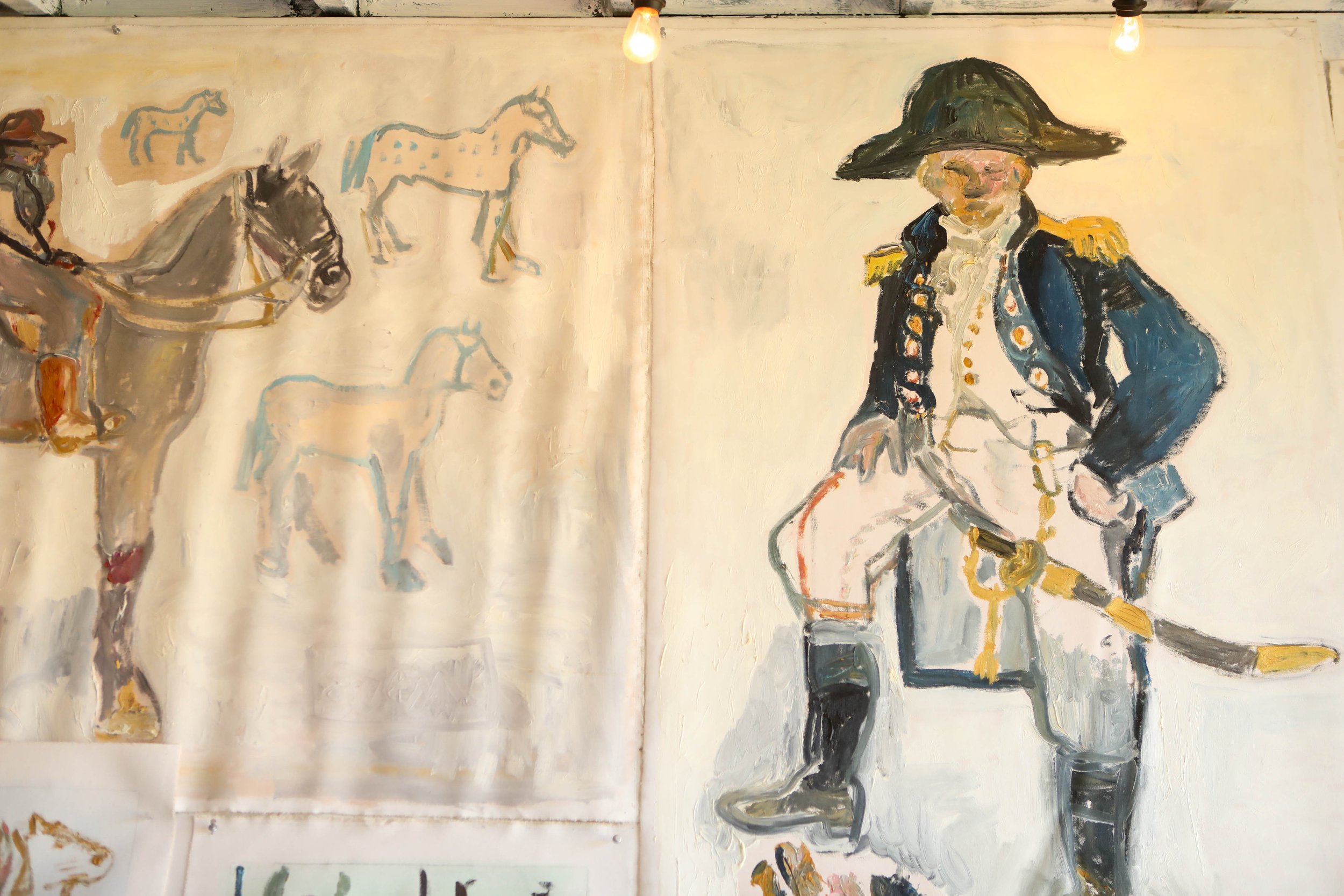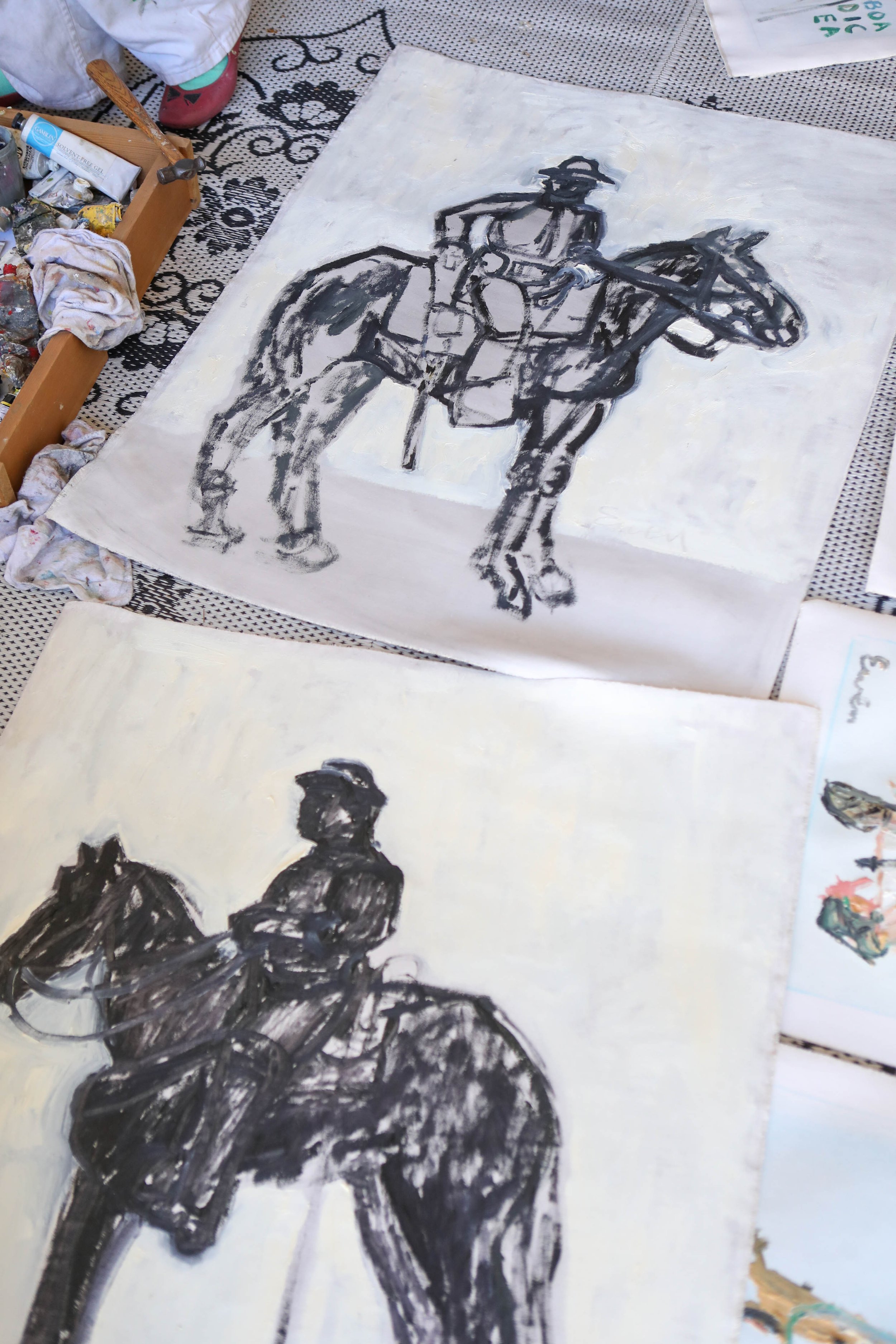The Beauty Surrounding Me — A Conversation with Anne-Louise Ewen
Ben Ashby
Los Angeles based artist, Anne-Louise Ewen, grew up in a small town on the Mississippi River in South Louisiana known equally for the beauty of its antebellum architecture as for its proliferation of toxic chemical plants. Anne-Louise’s work includes paintings, prints, drawings, sculpture, ceramics and books. In the current time of deep unrest in the United States, she wrestles to make paintings that she personally and viscerally finds beautiful while not being in denial of the dark realities we are facing as a society.
In the summer between second and third grade, I met one of my first art mentors in a chance encounter and spent that summer learning the fundamentals of drawing with charcoal, a formative experience which established visual art as a core element of my life. As a teen, I attended the Louisiana School for Math, Science and the Arts (a magnet boarding school) and concentrated on a curriculum of fine art, followed up by spending two years abroad studying figure drawing, printmaking and painting in Paris, France. I relocated from New Orleans to Los Angeles in 2005 following the massive upheaval caused by Hurricane Katrina and went on to pursue a college degree in philosophy which led me to later founding The Donaldsonville Art Colony, a collective of painters, writers, musicians, and filmmakers. I drew upon this experience years later when I opened my art gallery in Costa Mesa, California in 2007.
Creating is a powerful antidote to many of the world’s ills. It reminds me of humanity’s better nature. When I’m creating, I feel like I belong more on this planet than at any other time. Being creative is similar to being resourceful; having the ability to make something out of what you have at hand and do it elegantly when possible. Mere consumption and survival are not enough—the urgency in surpassing this is a part of what drives us to create.
I will never actually identify as or with the term of being a “creative”. For me, that expression always implies creative work that is applied to a commercial endeavor for the main purpose of making money. Don’t get me wrong—I very much like making money, but one thing that is important to me is remembering that there is a difference between art and commerce. And when you’re making art, you can start from a place that is not about marketing and selling and making a buck, but rather aim to create beautiful things that transcend oppression, violence, hate, ignorance and existential ennui.
To be frank, and I know this goes against a lot of contemporary art career advice, I don’t think it’s helpful, as an artist, to concern yourself with finding a style. It’s something that develops from experimenting and playing, and following a thread to something that you love. I’m still curious to see how I will paint or draw this or that. I try to make things that are beautiful to me and that I want to have around. I guess I’ve been painting for long enough that there is a lot of partially conscious, subtle figuring going on inside, but there’s always some aspect of leaping into the void. The key for me is to find a balance between bold spontaneity and calm deftness.
I believe that art’s highest good is as an outpost of freedom and a trigger of joy. I’m interested in art that makes me feel in love with the world, and I believe that artists have the ability and responsibility to restore humanity through what we do. Some have said that looking at my work makes them feel more free and alive, and I’d consider that my biggest accomplishment and the highest compliment.
I grew up in a dynamic where the people I came in contact with were either utterly indifferent to the creative work I was doing, or they were actively antagonistic (with many exceptions, of course!). Over the years, I, therefore, developed in a way that preferred working in isolation—my creative community was made up of the dead artists that I loved, like Matisse and Picasso and of the classical music or jazz on the radio, beaming in from Baton Rouge or New Orleans.
In recent years my creative community has changed some, but it’s a hard habit for me to break. I used to think that I didn’t have anything to say about my work, but now when someone visits my studio, I really enjoy the dialogues that come out of their questions and observations. I love it when someone experiences a connection with something I’ve made, and they say it makes them feel more free, happy and alive. That’s a fantastic part of the equation that was missing from my creative pursuits for a long time.
Surprisingly, my community of artists these days is greatly made up of musician-composers (the most important being my husband, Tyler Sabbag, who is a part of a team of composers best known for their work on the Netflix series, Street Food and Chef’s Table.). I love that they believe, value and understand things that can’t be seen, and this is the kind of person that I like to be around. It’s a never-ending source of fascination for me to discuss the similarities in our work processes. In both of our worlds, we must proceed by a kind of faith and hope to enter a state of grace where the composition evolves into something profoundly wonderful.
Creativity is renewing. When I’m feeling bummed out and don’t feel like I have it in me to paint, however, I may choose to simply work in a different medium, maybe ceramics one day, or I’ll make candles or play ukulele instead. Sometimes, just taking a break and sitting down to a good meal in a pretty setting will do the trick. I also appreciate the way that travel gives me a chance to be “the me” that I am without the errands and the to-do list crowding in on me, allowing me to find the space I need to dream again.
Pursue your creativity—Don’t overthink it.
Feel your way. Play.
Creative inspiration can come from anywhere though I do find I regularly find creativity in the beauty surrounding me. There is so much power in beauty to nourish and soothe us—a trip to Huntington Gardens in Pasadena, seeing my friend Teressa Foglia’s beautiful hats on Instagram, opera, baseball— I want to amplify that and bring it into people’s lives. I’m interested in seeing what happens next. The best times are when it feels like I just get to show up, set up my materials and ride the ride. I often feel as many artists do—like it’s not me making the work but some force passing through me.
I love seeing other people’s beautiful, well-organized studios, but the one I have currently is not that. When we first moved in, my studio was dark green. You can see that I painted it white and hung up the string of lights to brighten it up. We’ve regularly moved from rental house to rental house in Los Angeles for the last decade so my studios have had to adapt to what’s available both in terms of space and finances.
We moved to our current house thinking that the garage would make a pretty decent studio for me. It’s not too small, though it’s always a challenge to find more storage. Unfortunately, it turns out it also leaks terribly in the rain, as well as, fills with dust and leaves from the area’s frequent wind storms. The first curtain I hung across the opening blew away in a windstorm, but this one has held for over a year, fingers crossed. On a positive note, my studio has several walls for me to tack up my canvas to paint on plus space for my paints and brushes and other assorted art supplies. I also built cinder block shelves that I added to hold my art books and other treasures. If I waited around for the perfect space I wouldn’t get anything done, so I make it work. (On a side note, we’re house hunting again, and we’ve agreed that we’ll be happy with a tiny living space as long as we have vast spaces for our studios.)
My studio is pretty quiet, apart from my husband composing next door, and it has good energy which is important. Our house is an extension of my studio; I have an area for ceramics and candles, am often making at the kitchen table and use the living room as my rotating art gallery for studio visitors.
As an alternative, I’ve tried renting a studio space away from home, but this didn’t work for me. I need to live with my studio so I can wander out with a cup of coffee in the morning to see what I made the night before. I need to be able to carry wet paintings into the house to live with them a while and see what they feel like.
Realistically, it can be incredibly challenging to carve out the space you need, and you might find you have to be quite resourceful and flexible to make things work. I feel it is important to set up a creative space whatever the size so that it feels like your secret clubhouse hideout from childhood; someplace that you stock with the supplies that will excite you. If you don’t have a room, have a stocked suitcase that you can bring out and conjure that sacred space where you are free to do whatever you want. When I lived in New York City for a year, I had no studio space and so I turned to making small hand-bound art books of tiny paintings. The studio and the work will influence each other. Your available space doesn’t have to hold you back from making something. In our last house, I set up a giant tent in the backyard!
I think it’s an accomplishment to overcome these challenges and not let them hold me back from creating. I have a vision in my head of my ideal studio…big, bright and clean, with plenty of storage for finished work…I’ll get there eventually.
ANNE-LOUISE’S PAINTING MANIFESTO
Aim to proceed with a devil-may-care work ethic, both cheerful and reckless to investigate, invent and rediscover.
Let the first-hand personal experience of aesthetic arrest be the true north that guides me, allowing room for an epiphany.
Aim for nothing less than to create things that transcend oppression, violence, hate, ignorance and existential ennui.
Focus on the music over the lyrics. In other words, though there are recognizable objects in my paintings, the subject matter (the “lyrics”) is not what primarily motivates me.
Be virtuous in sharing my work with the world
“IMPORTANT” ART
I feel strongly that people should be more discerning about when they use the word “important” to describe art. Often what they mean is that a particular work of art or artist is currently influential, popular or expensive. This does not make it important. What the world needs more of are cultural offerings, which inspire and strengthen humanity's more virtuous qualities like empathy, sensitivity to beauty and love of life.
MORE ON ANNE-LOUISE
Online store: EwenStudio.com
Portfolio: EwenFineArt.com















